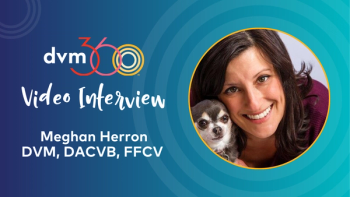
Treatment options for storm phobic dogs (Proceedings)
Often referred to as thunderphobia, but for many dogs other storm related stimuli are at least as, if not more important, than the sounds of thunder.
Often referred to as thunderphobia, but for many dogs other storm related stimuli are at least as, if not more important, than the sounds of thunder.
Phobia
- Fear reactions that
- are persistent over time
- are consistent in terms of what causes the fear
- are learned, irrational, not adaptive
May be, but is not necessarily intense (hysteria, catatonia, panic)
“Normal” Fear vs. Phobia
- Experiencing fear every time a hungry lion charges at you is normal (run, hide, defend)
- Experiencing fear when lightning hits a nearby tree is normal (run, hide)
- Experiencing fear every time there is a dark cloud in the sky is a phobia
Interaction of Stimulus X Fear
- Possible Causes
- Genetic Factors
- Traumatic/Aversive Events
- Restricted Early Experiences
- Unintentional Reinforcement
Relevant stimuli
- Sound:Thunder, Wind through trees, Branches hitting house, Rainfall
- Sight: Lightning flashing, Branches Waving, Darkness
- Smell: Odors raised by wind and rain
- Other
- Change in Barometric Pressure
- Change in Ionization
Management steps
- Punishment
- Under NO circumstances should punishment be used
- Relaxation…
- Keeping the pet calm and relaxed in general is an very important part of treatment
- Sit/Stay/Relax exercises
Treatment may be simple
- Bring the dog indoors during the storm
- Provide television or radio “noise”
- Dog may be ok as long as owner is present
- Provide “safe hiding place”
- Bathtub
- Laundry basket
- Closet
- May be serious and not respond to simple treatment
- Serious injury
- Significant damage
- Upset owners
- Owner-pet bond
- Re-homing
- Euthanasia
Composite fear
- thunder, lightning
- change in barometric pressure, ionization, illumination
- Simple techniques not always effective
Set realistic goals
Treatment
- Anxiolytic medication
- Maintenance drug: gets daily
- Fast-acting drug: gets as needed
- Behavior modification
Maintenance drug
- At least for length of storm season
- Relief from chronic, mild to moderate anxiety
- Some anxiolytic effect if owners miss storm-specific dose
Fast-acting Drug
- To get dog through the storm NOW
- Maintenance drug may not be sufficient when severe storm immediately overhead
- Fast-acting, strong anxiolytic effect
- Some notable for anti-panic effects, especially alprazolam
Behavior modification
- Desensitization and Counter-Conditioning
Maintenance drugs
- Tricyclic antidepressant
- Clomipramine: 2 mg/kg b.i.d.
Selective serotonin reuptake inhibitor
- Fluoxetine: 1 mg/kg daily
- Paroxetine: 1 mg/kg daily
Fast acting drug
- Alprazolam: 0.02-0.1 mg/kg
- Clonazepam: 0.1-0.5 mg/kg
- Clorazepate: 0.5-2.0 mg/kg
- Diazepam: 0.5-2.0 mg/kg
Ds&cc
- Expose pet to a very low level of stimulus
- Counter-condition with food when relaxed or playful
- Very gradually increase the intensity of the stimulus until it approximates actual levels
- If at any time the pet experiences anxiety or fear, move back to lower stimulus level
- Time-consuming
- May be useful if dog shows clinical signs during “mock” storm (i.e. CD recording)
- May work for the noise component of the fear
- Need to narrow down part of storm dog is fearful of
- Don't start with thunder if dog is afraid of rain
- Start with least threatening stimulus
- Light Rain < Heavy Rain < Soft Thunder, etc.
- May be best to DS&CC off storm season. However, this is usually not possible.
- Goal is for animal never (ideally) to experience fear
- Make sure that dog is never anxious
- Reward calm and relaxed behavior
Other treatments
- D.A.P. (CEVA)-No double-blind placebo controlled proof of efficacy
- Dramatic improvement seen in some cases
- No apparent effect in others
Storm Capes and Shirts
- Various styles on the market
- Anti-static cape (Storm Defender®) not more effective than a placebo cape.
- Cottam and Dodman (2009) Comparison of the effectiveness of a purported anti-static cape (the Storm Defender®) vs. a placebo cape in the treatment of canine thunderstorm phobia as assessed by owners' reports. Appl Anim Beh Sci 119:78-84.
Research trial
- Clomipramine
- 2 mg/kg b.i.d. for 90 days
- then 1 mg/kg b.i.d. for 14 days
- then 0.5 mg/kg b.i.d. for 14+ days
- until actual exit visit
- If no improvement at 30-60 days, increase dose to 3 mg/kg b.i.d.
- If unacceptable side-effects not severe enough to require exit, decrease dose to 1 mg/kg b.i.d.
Alprazolam
- 0.02 mg/kg given prior to storms
- Can repeat dose every 4 hours up to 4 times/24 hours
- Post hoc: Increase alprazolam dose up to 0.05 mg/kg in conjunction with clomipramine if lower dose is insufficient
- Do in a stepwise fashion
Behavior modification
- Do not comfort dog during storms
- In some cases, attention-seeking behaviors during storms will increase due to owner response
- Systematic DS&CC with Storm CDs
- Start with least threatening stimulus
- Reward dog for relaxed behavior
SPA scale at Baseline, 30, 60, 90, 120 Days
- Destructiveness 1-5
- Elimination 1-5
- Excess salivation 1-5
- Excess vocalization 1-5
- Hiding 1-5
- Pacing 1-5
- Panting 1-5
- Remains near owner 1-5
- Self-trauma 1-5
- Trembling 1-5
- Score of 0 if doesn't occur
- Total possible score: 0-50
Baseline Symptoms (N=The 38 Dogs That Made it to 30 Day Recheck)
Panting 95% (36/38) Pacing 92% (35/38) Trembling 92% (35/38) Remain by owner 87% (33/38) Hiding 84% (32/38) Excessive salivation 76% (29/38) Destructive 63% (24/38) Excessive vocalization 58% (22/38) Self-trauma 34% (13/38) Elimination 32% (12/38)
Owner Report at 30 Days (N=38) Worse 1 Unchanged 12 Somewhat better 18 Substantially better, not resolved 7
66% of dogs have shown some improvement at 30 days
Owner Assessment of Overall Improvement at 120 Days (N=32) Worse 0 Unchanged 2 Somewhat better 16 Substantially better, not resolved 12 Resolved 2
94% show some improvement by 120 days and no patients got worse.
Change in SPA scores
- The total score decreased significantly (p=0.000)
- For all individual behaviors the score decreased significantly
Predictability of 30 Day Response?
- Significant correlation of total SPA score between improvement at 30 days and total improvement at 120 days
Long term effect?
- 240 days after discontinuing the study mean scores for all behaviors were lower than at baseline.
Newsletter
From exam room tips to practice management insights, get trusted veterinary news delivered straight to your inbox—subscribe to dvm360.





